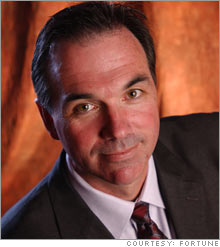 |
| Billy Beane says that baseball front offices now resemble arbitrage desks. |
|
|
|
|
|
NEW YORK (CNN/Money) -
Billy Beane says he's an unlikely choice for being the business world's favorite sports executive.
But the general manager of the small-revenue Oakland Athletics has become just that. He became famous outside the world of sports fans when he was subject of the 2003 book "Moneyball" by Michael Lewis.
The book detailed how Beane and other executives at the hand-to-mouth A's used statistical analysis rather than just traditional scouting methods to identify and acquire under-valued players who could help their team win.
And win they did, as the team has the fifth best record in baseball since he took the reins in 1998, and is only a win or two behind a couple of the biggest spending teams during that time: the Boston Red Sox and St. Louis Cardinals.
"We're trying to find micro-cap players and pay for future performance and eliminating paying top dollars for veterans whose peak performance is in the past," he told attendees at Fortune magazine's "Innovation Forum" in New York this week.
The A's strategy of using more statistical analysis has spread across the sport, as teams turned to young college-educated analysts rather than former players to make decisions on players. Two of his former assistants, neither of whom played ball, have become general managers on other teams, and the Red Sox won their first championship in 86 years using greater reliance on statistical analysis.
"The front offices no longer look like good-old-boys clubs. They look like the Goldman Sachs arbitrage desk," he told the conference. "In 10 years I won't be able to apply for this job."
Afterwards, Beane told me he's amazed by the recognition that he's gotten from the world of business since Lewis' book.
"Robert Rubin wrote me a letter," he said. "That's flattering. That's humbling."
And he said that the sometimes grudging acceptance of his methods of using statistical analysis to determine how to build a winner has changed the market for players and made things tougher for small-revenue clubs such as his.
Five years ago most fans and executives paid attention to a hitter's batting average, which said how often they got a hit to reach base, rather than his on-base percentage, which said how often they reached base by hit or walk. Beane was able to get some high on-base percentage players at bargain prices.
"The market has significantly corrected itself," he said. "On-base percentage is the now the highest paid statistic in the game."
Because of those shifts, Beane said it's only going to get tougher for the small-revenue team to make up for their limitations by being smarter and finding value.
"Today the opportunities are diminishing quickly, and to me it's a product of some extremely bright people running teams," he said "In 10 years the front offices are going to look like arbitrage departments."
Changes limited outside baseball
But while baseball is changing in this way, the nation's other team sports are making far less moves towards changing the way they operate.
The only team from outside of baseball to pick up the phone and call Beane to ask for advice is the national cricket team of New Zealand, which sent a group of executives to Oakland to shadow Beane and his staff and learn their lessons.
"I don't know anything about cricket, but I guess Australia and India are like the Yankees and Red Sox and New Zealand is the Oakland of cricket," he said with a laugh.
The NBA's Seattle Sonics has made a greater push for unique statistical analysis to give the team an edge. But overall the changes in football and basketball are less widespread than in baseball.
Beane faced a lot of hostility to his calls to change the way the talent is judged, particularly from scouts and other executives who felt threatened.
I suggested to Beane that it was the salary cap and revenue sharing in football and basketball that have slowed the adoption of his methods in those sports, that without as free a market, and as great a disparity in payrolls, there isn't nearly the incentive to shake things up and go against the "old boys club," as he describes the former look of the baseball front office.
Beane said he's convinced his methods would work even better in leagues with those restrictions on the labor market.
"Do I wish everybody in baseball had the same amount to spend? Absolutely," said Beane. "At some point, the disadvantage of being a small-market team is that the inefficiencies will be weeded out. Having less than your competitor is never an advantage."
But Beane's modesty when speaking to executives at the Fortune forum also seemed to confirm that a competitive disadvantage found in baseball more than football or basketball was the mother of his form of innovation.
"It wasn't that we were innovative," he told the group. "We just didn't have a choice. We had the change the dynamics to keep up with the other teams."
___________________________________________
For a look at baseball's upcoming spending spree, click here.
For view of the "Moneyball" theory when the book first came out, click here.
For more on the business of sports, click here.

|